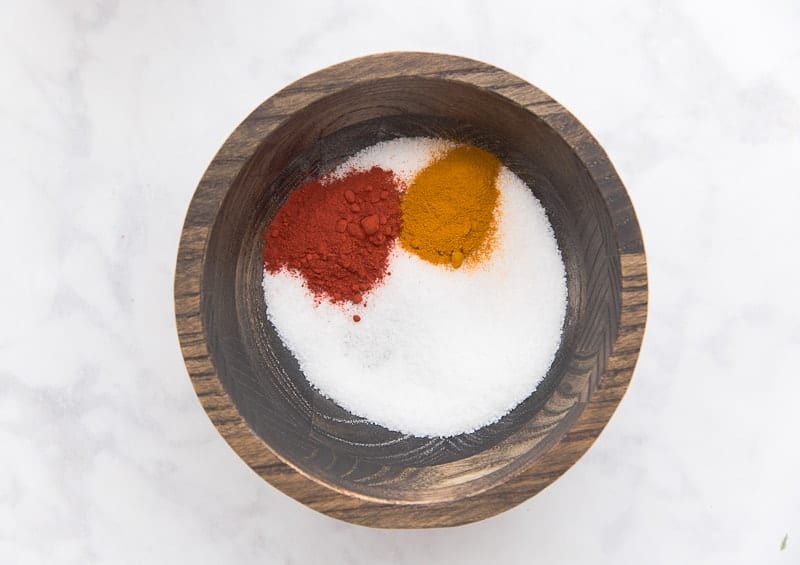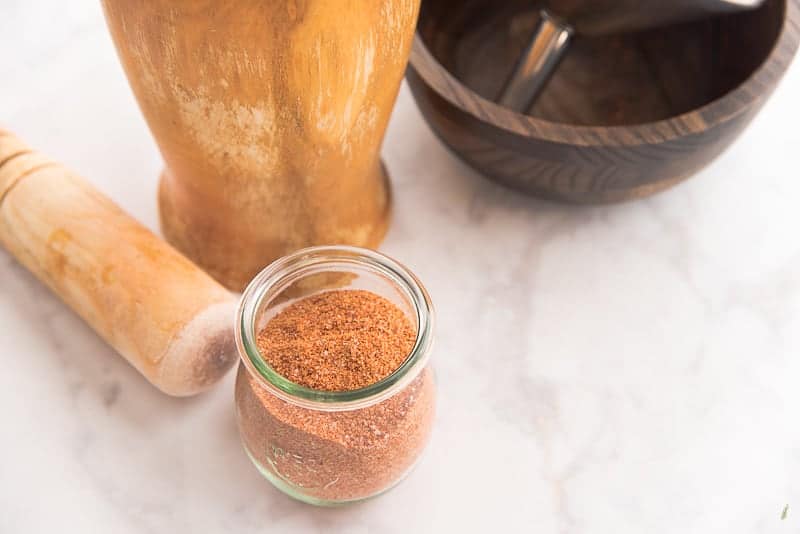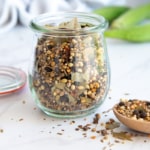Go into any Hispanic or Black person’s kitchen and you’ll probably find a box of Sazón there. Sazón is a flavor enhancing spice blend popular in Caribbean cuisines. Because of its ability to amplify the taste and color of most dishes, sazón is the preferred spice for rices to meats and everything in between. The biggest downfall to using it (for some people), however, is the fact that it contains MSG. We’ll discuss MSG a little further on, but I want to clarify: I don’t have an issue with it. My version of sazón eliminates it for those who do, though.
*I wrote this post days before the CEO of the world’s largest Hispanic food supplier made polarizing comments. As a result, images include the original product.*
What is Sazón?
Sazón is a spice blend which enhances the flavor of, and imparts color to, savory dishes like this Arroz con Gandules. The most common versions are con culantro y achiote (with culantro and annatto) or con azafrán (with saffron). Both of these varieties give the most color when added to dishes. The supporting spices: coriander, cumin, and garlic can be found in all sazón products. The types of coloring agents are what varies the most, as well as sodium levels.
MSG, or monosodium glutamate, is the backbone of most sazón blends. The issue with that is the reaction some people may have to it. This recipe eliminates the MSG entirely, making it a safe option for those with an MSG sensitivity. I include instructions for making it with MSG if you prefer the OG version, though.
What is Sazón made with?
For this homemade sazón you need salt, which is a big flavor of regular sazón. Garlic and onion provide more pungent notes, while the addition of cumin and coriander create warmth. Annatto and turmeric add a smidge of flavor, but, mainly, they’re for color.
Measure out the spices into prep bowls, because you’re going to need to process the salt a bit before mixing everything together.
Again, MSG may be added, but you’ll need to reduce the amount of salt you use to 2 tablespoons.
Is Sazón bad for you?
Since I know it’s going to come up, let’s just address this now.
Is sazón bad for us? In short, no.
Sazón, itself, is not bad for your health unless you have high blood pressure. Even then, you would have to eat spoonfuls of it on a daily basis in order for it to cause you harm. So, like most spice blends that contain salt, you should eat it in moderation. It’s odd to me that the main argument against the use of sazón is the MSG it contains, while no one bats an eye at the sodium content.
This recipe has less salt, overall, than store bought sazón. That said, use it as you would any other seasoned salt- in moderation.
Is MSG bad for you?
Many studies have been done which debunk the medical claims against MSG. Is MSG bad for your health, or is it all a scam created to keep our food flavorless?
I, personally, have never experienced side effects from eating dishes made with MSG. That, however, doesn’t mean that others don’t have a legitimate sensitivity to it. The fact of the matter is, you know yourself (and your health) better than I. If you have a reaction after eating food prepared with MSG, don’t add it. If you’re fine eating it, go for it. I’m not here to judge you. But, no, to my knowledge, MSG in moderation and when used properly to season foods, is not bad for you.
How does Sazón get its color?
One of the main reasons sazón is used in food is to give it great, vibrant color. The red-orange hue of a pot of Puerto Rican arroz con gandules (rice with pigeon peas) is proof positive that someone added a couple of packets of sazón to it.
But, where does that color come from?
Achiote, or annatto, are little pebble-looking seeds that comes from the center of the fruit of the achiote tree. Back in Puerto Rico, little bad-ass boys (like my husband) used to torment girls by throwing these seeds at them: staining their clothes, thus, getting them into trouble.
Annatto isn’t eaten by itself, however. Mainly, it’s added to other dishes to color them. That orange colby cheese you find in your deli? It more than likely obtained that hue from annatto.
Badia annatto in powdered form is what I use to give my sazón color. Be careful that you don’t pick up achiote paste as that will do you no good in this recipe. The paste must be mixed with a liquid to make it suitable for use in recipes. As you can see, that won’t do in a recipe for something designed to be stored in the pantry for months at a time. Instead, make sure your annatto is in powdered form.
Turmeric is also added in addition to annatto, which adds even more color to our recipes. Turmeric is notoriously pigmented- if you’ve ever tried to get turmeric stains off of your skin, you understand just how much color it actually imparts.
Well, between the annatto and the turmeric, I think our coloring is well-covered.
How do I make a spice blend that pours well?
One thing that tends to bug me about homemade spice blends is the grains of kosher salt, which are always a different size than the rest of the spices. That means the salt settles at the bottom of the jar and stays there when you attempt to use the sazón.
To lower the chances of this happening with my sazón, I crush the salt prior to adding it to the rest of the ingredients. Sure, you can use a finer iodized salt, but I never cook with it, which means I don’t have it in my home. In fact, I don’t even recommend iodized salt unless you have a dietary need for it.
Pour the salt into a pilón (mortar and pestle) and grind it for a minute or two to crush the salt into a fine powder. It won’t be the consistency of powdered sugar, but should be much finer than when you began. Alternatively, use a spice mill (or coffee grinder) and pulse the salt a few times to break down those larger granules.
Combine the spices
Pour the salt into a mixing bowl. Add the coloring elements- the ground annatto and ground turmeric to the bowl along with the salt. If you’re really balling, add 2 or 3 saffron threads for even more color.
Now add the earthy spices: the ground coriander and cumin. The cumin tastes pungent and warm, while the coriander (the seed from which cilantro comes) adds a mellow vibrance to the blend.
Finally, add the granulated garlic and onion to the bowl. These aromatics are all you need to add a huge burst of flavor to your recipes. Here’s where you add the MSG if you decide to use it.
Combine and Compare
Use a small whisk to blend the spices together. The sazón should be one general color, with no pockets of any one color (like a bunch of white from the salt).
I poured a packet of store-bought sazón into the glass bowl in the top right. Our sazón is in the big bowl, bottom left. Clearly, ours looks more homemade. There’s no red 40 or yellow 5 (artificial dyes) to make it the same neon orange as the store-bought version.
Our sazón looks tastier, too, in my opinion.
How do I store my spices?
When storing seasonings like this sazón, it’s best to do so in a glass jar that has a tight-fitting lid.
Weck jars are not only cute as a button, they’re functional. I store all of my spice blends in them. Mason jars also work well.
Use a funnel to transfer the sazón to your jars.
Tightly seal them and store them in the pantry- away from the stove.
I cringe when I see spices stored above, or right next to, the stove. The heat and steam produced by cooking can cause the spices themselves to swell with moisture, which makes them lose their potency… it’s just a hot mess. If you have a drawer a few steps from the stove, that’s even better.
How long can I store Sazón?
As with most spices, sazón is good- if stored properly- for 1 year. That’s about how long it takes for the spices to lose their maximum potency. The longer you keep your spices, the more you’ll need to use to get the same amount of flavor in your recipes. That’s not a horrible thing, but it’s wasteful- so, use it up!
What do I use Sazón for?
Use this sazón in any recipe that requires seasoning. A tablespoon of this sazón flavors and colors 3 cups of white rice beautifully. Chicken, pork, or beef and this stuff is heaven- roasts, especially! Feel free to use more as needed to suit your taste or to achieve the color you desire.
Make sure you label your jar so others know how much to use- don’t forget to include the date you made it. Also, do be sure to pin this Sazón recipe so you have it handy whenever you run out.

Sazón Seasoning Blend
at Sense & EdibilityEquipment
- mortar and pestle
Ingredients
- 1/4 cup kosher salt reduce to 2 tablespoons if using MSG (see note)
- 2 tablespoons granulated garlic
- 1 1/2 tablespoons granulated onion powder
- 1 tablespoon ground annatto
- 1 tablespoon ground cumin
- 1 1/2 teaspoons ground coriander
- 1 teaspoon ground turmeric
- 1/2 teaspoon ground black pepper optional
Instructions
- In a mortar and pestle, grind the salt until fine. This breaks the salt down to the same size as the ground spices.
- In a mixing bowl, combine the salt, garlic powder, onion powder, annatto, cumin, coriander, turmeric, and black pepper (if using).
- Whisk the spices together until blended well.
- Transfer the sazón to a jar with a tight-fitting lid. Store in a cool, dark place for 6 months or less.
- Use as desired; 1 1/2 teaspoon equals one packet of sazón, while a portion size is 1/2 teaspoon.



















Just reread and you can delete this and my prior comment— I must have skimmed before, and now I see that you do include amounts for msg.sorry about that!
No worries and I’m glad you’re on board!
Question: I am fine with msg but prefer to avoid food coloring. How much msg would you add to this recipe? I have Aji-no-moto msg.
Just found your blog and am excited to cook from it! I grew up in a Puerto Rican neighborhood and have been missing those flavors since my family went vegan.
This is literally the first ever recipe I actually read all the way through—so thoughtful, knowledgeable, funny and LEGIT since you’re part Boricua. 🇵🇷
Thank you for sharing —I’m about to make your recipe right now!
I know how HUGE it is for someone to read a recipe all the way through these days, so thank you!